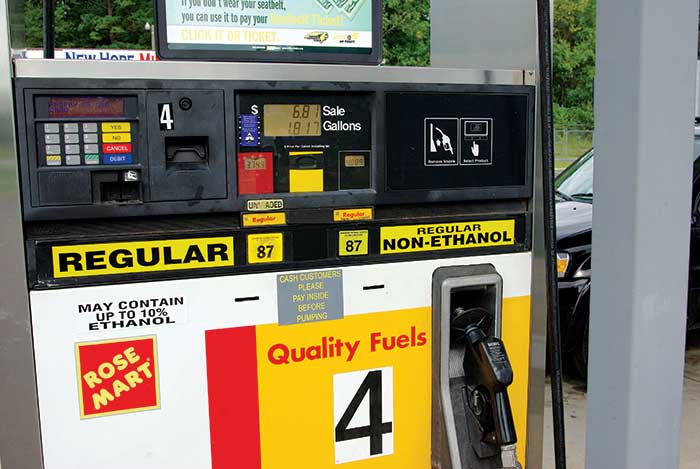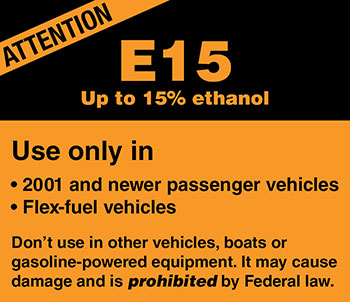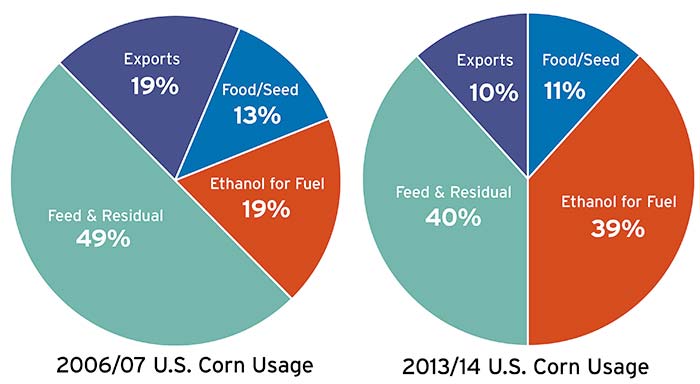Advertisement
Congress pops the hood on America's fuel policy and finds there’s work to be done, especially on E15.

Gas consumption has been on a slight decline since 2007.
A turkey farmer, an environmental activist, and a boater walk into a congressional hearing on Capitol Hill. That may sound like a joke in the making, but it actually describes a few of the diverse witnesses who marched up to a hearing on a hot, muggy June 5 to tell Congress that a once well-intentioned national fuel policy has outlived its usefulness. Add to this unlikely group a motorcyclist, a gasoline refiner, and a classic-car collector, and you start to put a new face on the nation's renewable fuel debate.
Back in 2005, Congress passed the Renewable Fuel Standard (RFS) as part of a sweeping energy package designed to reduce the country's dependence on foreign oil by blending more homegrown renewable fuel in our gasoline. The RFS is the formula that mandates the annual volume of renewable fuels refiners must blend into the nation's fuel supply, most significantly into gasoline. Ethanol, a corn-based fuel, grew to have the lion's share of the renewable market and currently 90 percent of the nation's gasoline contains 10 percent ethanol. Although the transition to this fuel was rocky for boaters, motorcyclists, snowmobilers, and other small-engine owners, most of the public adapted. But today the country is using less gasoline, and there's a different transition approaching, one that may prove too much for our shrinking fuel supply to bear.
"It's ironic to think that fuel efficiency is part of the problem," said Former BoatUS President Margaret Podlich. "But the combination of more stringent fuel-efficiency standards, a recession, and the growing American concern about fuel usage has decreased the amount of fuel we use. That's a good thing. But with the country as a whole becoming more fuel efficient, it means there's less gasoline to mix with increasing volume requirements of renewable fuel." According to the U.S. Energy Information Administration (EIA), gasoline consumption peaked in 2007, and has been on a slight decline ever since. "When you no longer can add more ethanol to gas at a safe level for the public, you run right into the ‘blend wall,'" added Podlich. Boaters may think that the RFS and so-called blend wall don't really affect their favorite pastime, but an odd set of factors are aligning to create a hurdle in America's fuel policy that could hit boaters square in the wallets.
E15, The Straw The Camel Feared

The current EPA label for E15 prohibits use in boats.
In 2010, the Environmental Protection Agency (EPA) approved the debut of a fuel that contains 15 percent ethanol. Under the EPA's own regulations, it can't be used in boats, motorcycles, lawnmowers, or cars built before 2001, and it will void some newer car warranties. According to the National Marine Manufacturers Association (NMMA), there isn't one marine engine warrantied to use more than a 10-percent blend of ethanol gas. Additionally, higher blends of ethanol gas deliver fewer miles per gallon and less power. So why would the EPA endorse E15 to the market?
The EPA's goal was to put more ethanol in fuel to meet rising mandates, rather than use their option or waiver authority to reduce the volume requirements. Refiners are still able to produce boater-friendly ethanol-free gas, but it costs them more in regulatory penalties, making it more difficult to sell and adding costs that get passed down to the consumer. A recent study prepared for the American Petroleum Institute by National Economic Research Associates, a group also used by the U.S. Department of Energy, found that by 2015 the combination of higher compliance costs imposed on refiners plus a reduced domestic fuel supply could increase the cost of producing gasoline by 30 percent and the cost of producing diesel by as much as 300 percent.
Advertisement
Proponents of the RFS disagree that the financial impacts of the blend wall are that drastic, claiming that potential reforms to the law will limit the choice of fuel options for consumers. Bob Dineen, president of the Renewable Fuels Association (RFA), believes the blend wall has been "self-inflicted" by the oil industry, that it's "a false facade built by the oil companies to protect their oil monopoly." Regardless of what factors have brought about the blend wall and the reality of it on consumers, the situation now has the attention of Capitol Hill.
Winds Of Change
A strong new wind has begun to blow in Washington, as serious lobbying efforts from once-opposing sides mount to change the RFS. It's rare for any issue to land so many hearings in a single session of Congress, or to unite such diverse bipartisan groups. In separate letters sent in the fall of 2012, 152 members of Congress, 40 U.S. senators, and 12 state governors asked the EPA to waive the RFS mandates, citing that the recent drought had seriously impacted their state's economies, and that continuing to keep up with the mandates would cause their states economic harm. According to their letters, 40 percent of all domestic corn is currently being used for fuel. "This means literally billions of dollars in increased costs for livestock and poultry producers, and food manufacturers," stated one letter.
Collateral Damage
The press describes this war on the domestic fuel policy as pitting renewable fuel and ethanol producers against the traditional oil and gas refiners. However, it's more nuanced than that, and the collateral damage is nationwide Ñ from hunger-relief organizations dealing with increased domestic grain costs, to U.S. poultry and pork operations closing and eliminating jobs. According to Dr. Thomas Elam, president of FarmEcon, an agricultural consulting firm, since 2008, "eight major poultry producers have filed for bankruptcy." And finally, you have boaters, who just want an affordable fuel that won't damage boat engines.
According to Charlie Drevna, president of the American Fuel & Petrochemical Manufacturers, "For boaters and other consumers, the impacts of the RFS are not just limited to higher food prices, higher emissions, or increased possibility of engine damage. If Congress doesn't act, the RFS will force refiners to make tough choices ... to either sell ethanol blends higher than cars, boats, and infrastructure can safely handle, or begin limiting the amount of gasoline and diesel they sell in the U.S." (When domestic refiners export their products, the fuel does not have to be blended, nor is a penalty assessed for ethanol-free fuel, so the product subsequently costs less to produce.)

During the past seven years the amount of corn being used to produce ethanol for fuel has doubled.
When the RFS was born, America was at its peak of dependence on foreign oil, and renewable fuels were believed to be America's ticket to oil independence. What the policy failed to predict was the degree Americans would reduce their fuel usage, necessitating higher blends — which create the compatibility issues — in order to reach mandated renewable fuel volumes.
Reform Or Repeal
BoatUS supports renewable fuels as part of the national fuel strategy. However, the move to put higher blends, like E15, into the marketplace creates serious problems for boaters. On June 5, BoatUS submitted testimony to the House Oversight Committee on Energy, going on the record to ask Congress to reduce the RFS mandate, and citing studies conducted by the U.S. Department of Energy that showed the devastating damage to marine engines using higher blends of ethanol like E15. "Reducing the mandate will prevent the artificial stimulation and promotion of 15-percent ethanol fuel, a fuel that is poison to all existing boat engines," wrote BoatUS's Margaret Podlich. Since then, EPA has announced the anticipated 2013 renewable fuel volume requirements which changed very little. However, EPA officials did acknowledge that the impending blend wall and shrinking fuel demand will greatly alter the 2014 numbers.
Now Congress must decide to either reform the RFS to better reflect current gasoline usage and the lack of other renewable fuel options, or eliminate it all together. Hearings on the RFS are likely to come in late fall. BoatUS will continue to advocate for you as this policy moves along, and we encourage you to tune in regularly to our BoatUS Government Affairs website for updates on RFS reform and other issues affecting boaters.
